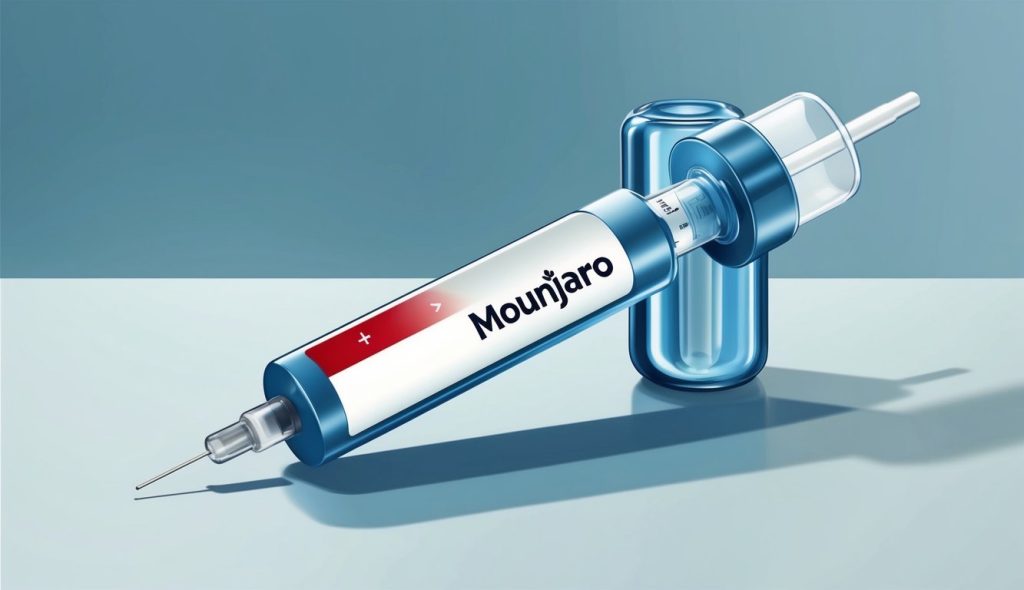Carnivore diets and Mounjaro have both gained attention for their potential weight loss effects. The carnivore diet focuses on consuming only animal products, while Mounjaro is a medication prescribed for managing type 2 diabetes. Some individuals have explored combining these approaches in their health journeys.
Mounjaro can lead to significant weight loss of up to 22% when paired with a low-calorie diet and increased physical activity. This medication works by regulating blood sugar levels and reducing appetite. The carnivore diet, though not scientifically supported for long-term health, has anecdotal reports of weight loss success from its proponents.
Combining Mounjaro with a carnivore diet may present challenges. Mounjaro slows digestion, potentially necessitating fiber intake, which is absent in a strict carnivore regimen. Additionally, the long-term effects of an all-animal product diet remain unclear. Those considering this combination should consult healthcare professionals to ensure safety and efficacy for their individual needs.
Understanding Mounjaro

Mounjaro, also known as tirzepatide, is a groundbreaking medication for managing type 2 diabetes and promoting weight loss. It offers unique benefits through its novel mechanism of action.
Mechanism of Mounjaro (Tirzepatide)
Mounjaro works by mimicking two natural hormones in the body: GLP-1 and GIP. These hormones help regulate blood sugar levels and appetite.
Tirzepatide activates GLP-1 and GIP receptors, enhancing insulin secretion when blood sugar is high. It also slows down gastric emptying, which helps control glucose absorption.
The dual action on both hormone receptors sets Mounjaro apart from other diabetes medications. This unique approach leads to improved glycemic control and increased feelings of fullness.
Benefits of Mounjaro for Type 2 Diabetes
Mounjaro significantly improves blood sugar management in people with type 2 diabetes. Clinical trials have shown it to be highly effective in reducing HbA1c levels.
Key benefits include:
- Lower fasting and post-meal blood glucose levels
- Improved insulin sensitivity
- Reduced risk of diabetes-related complications
Patients often experience decreased appetite and calorie intake as side effects. This can lead to weight loss, which further improves diabetes management.
Mounjaro and Weight Loss Efficacy
Mounjaro has shown remarkable results in promoting weight loss. In clinical studies, participants lost up to 22% of their body weight when combining Mounjaro with lifestyle changes.
The weight loss effects are attributed to:
- Decreased appetite
- Increased feelings of fullness
- Slowed gastric emptying
These factors lead to reduced calorie intake without conscious effort. Many users report significant and sustained weight loss while using Mounjaro.
The medication’s dual-action mechanism appears to be more effective for weight loss than single-target therapies. This makes Mounjaro a promising option for those struggling with obesity alongside type 2 diabetes.
Potential Side Effects of Mounjaro
Mounjaro (tirzepatide) can cause various side effects ranging from mild to severe. Users may experience gastrointestinal issues, changes in blood sugar levels, and other physical reactions. Understanding these potential effects is crucial for managing treatment effectively.
Gastrointestinal Disturbances
Nausea is one of the most common side effects of Mounjaro. Many users report feeling queasy, especially during the initial weeks of treatment. Vomiting can also occur, though less frequently than nausea.
Diarrhea affects some patients taking Mounjaro. It typically resolves on its own but may persist in some cases. Conversely, constipation is another possible digestive issue.
These gastrointestinal side effects often diminish over time as the body adjusts to the medication. Staying hydrated and eating smaller, more frequent meals can help alleviate these symptoms.
Risk of Hypoglycemia and Dizziness
Mounjaro can lower blood sugar levels, potentially leading to hypoglycemia. Symptoms include shakiness, sweating, and confusion. This risk increases when Mounjaro is used with other diabetes medications.
Dizziness is another reported side effect. It may result from changes in blood sugar or as a direct effect of the medication. Users should be cautious when operating machinery or driving, especially when starting treatment.
Regular blood sugar monitoring is essential for those taking Mounjaro. Patients should work closely with their healthcare provider to adjust dosages and manage potential hypoglycemia risks.
Managing and Mitigating Side Effects
To minimize nausea, patients can take Mounjaro with food or adjust their eating habits. Small, frequent meals may be more tolerable than large ones.
For diarrhea or constipation, dietary changes can help. Increasing fiber intake for constipation or reducing it for diarrhea may provide relief.
If dizziness occurs, patients should avoid sudden changes in position and ensure adequate hydration. In case of severe or persistent side effects, contacting a healthcare provider is crucial.
Gradual dose escalation, as prescribed by a doctor, can help the body adjust to Mounjaro. This approach often reduces the intensity of initial side effects.
Patients should report any unusual or severe reactions to their healthcare provider promptly. Open communication ensures proper management and adjustment of treatment as needed.
The Carnivore Diet
The carnivore diet is a restrictive eating plan that consists solely of animal products. It excludes all plant-based foods, focusing on meat, fish, eggs, and some dairy.
Principles of the Carnivore Diet
The carnivore diet centers on consuming only animal-derived foods. Adherents eat beef, pork, chicken, fish, and other meats as their primary source of nutrition. Eggs and some dairy products may be included.
All plant-based foods are eliminated, including fruits, vegetables, grains, legumes, nuts, and seeds. The diet emphasizes protein and fat intake while minimizing carbohydrates.
Proponents claim this approach can lead to weight loss, improved mental clarity, and reduced inflammation. However, these claims lack substantial scientific evidence.
Advantages and Challenges
Potential advantages of the carnivore diet include simplicity in meal planning and preparation. It may lead to rapid weight loss due to its restrictive nature and low carbohydrate content.
The diet is high in protein, which can help preserve muscle mass during weight loss. Some followers report increased energy levels and reduced digestive issues.
Challenges include nutrient deficiencies, particularly in fiber, vitamins, and minerals found in plant foods. The high saturated fat content may increase cardiovascular risk for some individuals.
Social situations can be difficult to navigate due to the diet’s restrictive nature. Long-term sustainability is a concern, as the diet lacks variety and may be challenging to maintain.
Carnivore Diet and Diabetes Management
The carnivore diet’s impact on diabetes management is complex. Its low carbohydrate content may help stabilize blood sugar levels in some individuals with diabetes.
Eliminating carbs can lead to improved insulin sensitivity and reduced medication needs for some diabetics. However, the diet’s high protein content may increase insulin requirements in others.
The lack of fiber and plant-based nutrients may negatively affect gut health and overall metabolic function. Long-term effects on diabetes management remain unclear due to limited research.
Individuals with diabetes should consult healthcare professionals before adopting a carnivore diet. Close monitoring of blood glucose levels and medication adjustments may be necessary.
Formulating a Mounjaro-Friendly Diet

A well-designed diet plan can enhance the effectiveness of Mounjaro treatment. Focusing on nutrient-dense foods while limiting less beneficial options helps support weight loss and blood sugar management goals.
Recommended Food Groups
Lean proteins form a crucial component of a Mounjaro-friendly diet. Options include chicken breast, turkey, fish, and lean cuts of beef. These protein sources help maintain muscle mass during weight loss.
Non-starchy vegetables should make up a significant portion of meals. Broccoli, spinach, cauliflower, and bell peppers are excellent choices. They provide essential nutrients and fiber while being low in calories.
Whole grains can be included in moderation. Quinoa, brown rice, and oats offer complex carbohydrates and fiber. These foods help stabilize blood sugar levels and provide sustained energy.
Fruits should be consumed in controlled portions due to their natural sugar content. Berries, apples, and citrus fruits are good options. They provide vitamins, minerals, and antioxidants.
Foods to Avoid or Limit
Fried foods should be avoided as they are high in unhealthy fats and calories. These can interfere with weight loss efforts and potentially exacerbate digestive side effects of Mounjaro.
Refined carbohydrates like white bread, pasta, and sugary snacks should be limited. These foods can cause rapid spikes in blood sugar levels, counteracting the medication’s effects.
Sugary beverages, including sodas and fruit juices, should be eliminated. They provide empty calories and can lead to blood sugar fluctuations.
High-fat dairy products should be consumed sparingly. Opt for low-fat or fat-free alternatives when including dairy in the diet.
Mounjaro Diet Plan Principles
Portion control is essential when formulating a Mounjaro-friendly diet. Using smaller plates and measuring servings can help manage calorie intake effectively.
Meal timing should be consistent. Eating regular, balanced meals helps maintain stable blood sugar levels throughout the day.
Hydration is crucial. Aim for at least 8 glasses of water daily. This supports overall health and can help manage potential side effects of Mounjaro.
Incorporating nuts and seeds as snacks can provide healthy fats and protein. However, they should be portioned carefully due to their high calorie content.
Monitoring sodium intake is important. Opt for fresh foods over processed options to reduce excess salt consumption.
Managing Diet and Lifestyle During Mounjaro Treatment

Successful Mounjaro treatment requires attention to diet, exercise, hydration, and blood sugar monitoring. These lifestyle factors play a crucial role in maximizing the medication’s effectiveness and promoting overall health.
Incorporating Physical Activity
Regular exercise enhances the effects of Mounjaro treatment. Aim for at least 150 minutes of moderate-intensity aerobic activity per week. This can include brisk walking, cycling, or swimming. Strength training exercises 2-3 times weekly help build muscle mass and boost metabolism.
Start slowly and gradually increase intensity. Listen to your body and adjust as needed. Physical activity improves insulin sensitivity, aids weight management, and supports cardiovascular health.
Consult a healthcare provider before starting any new exercise regimen, especially if you have pre-existing health conditions.
Importance of Hydration
Proper hydration is essential during Mounjaro treatment. Aim for 8-10 glasses of water daily. Adequate fluid intake helps:
- Regulate body temperature
- Support digestion
- Flush out toxins
- Prevent dehydration-related side effects
Avoid sugary drinks and limit alcohol consumption. Herbal teas and infused water can add variety. Monitor urine color – pale yellow indicates good hydration.
Carry a reusable water bottle as a reminder to drink regularly throughout the day.
Monitoring Glycemic Index
Understanding and managing the glycemic index (GI) of foods is crucial for blood sugar control. Choose low GI foods to maintain stable glucose levels:
| Low GI Foods | High GI Foods |
|---|---|
| Vegetables | White bread |
| Whole grains | Sugary snacks |
| Lean proteins | Soft drinks |
Pair high GI foods with proteins or healthy fats to slow glucose absorption. Keep a food diary to track GI intake and blood sugar responses.
Regular blood glucose monitoring helps identify trends and adjust diet accordingly. Consult a registered dietitian for personalized meal planning advice.
Important Considerations for Mounjaro Users

Mounjaro users should prioritize medication safety, adherence, and regular medical check-ups. These factors play a crucial role in optimizing treatment outcomes and managing potential side effects.
Ensuring Medication Safety and Adherence
Proper storage of Mounjaro is essential. Keep the medication refrigerated between 36°F to 46°F (2°C to 8°C). Before use, allow it to warm to room temperature for 30 minutes. Never freeze or use if frozen.
Administer Mounjaro once weekly, on the same day each week. Users can inject it with or without food. Set reminders to maintain consistency.
Rotate injection sites between the abdomen, thigh, or upper arm to prevent skin irritation. Clean the area with alcohol before injection.
If a dose is missed, take it as soon as possible within 4 days. If more than 4 days have passed, skip the missed dose and resume the regular schedule.
Regular Medical Consultations and Monitoring
Users should schedule regular check-ups with their healthcare provider. These visits allow for dose adjustments and monitoring of treatment progress.
Blood sugar levels should be checked regularly. Keep a log of readings to share with the doctor.
Report any side effects promptly. Common issues include nausea, diarrhea, and decreased appetite. Severe symptoms like persistent vomiting or severe abdominal pain require immediate medical attention.
Periodic lab tests may be necessary to assess kidney and liver function. These help ensure the body is tolerating the medication well.
Users with a history of pancreatitis or thyroid cancer should inform their doctor, as extra monitoring may be required.
